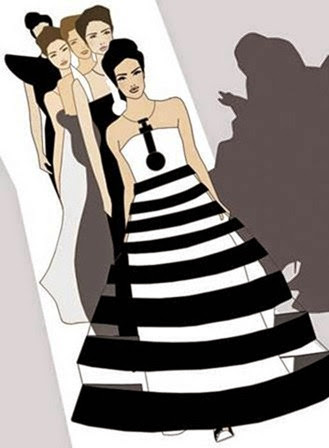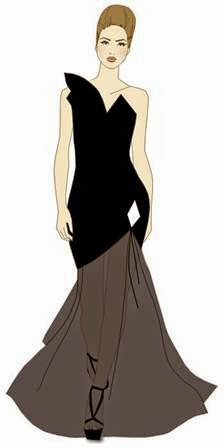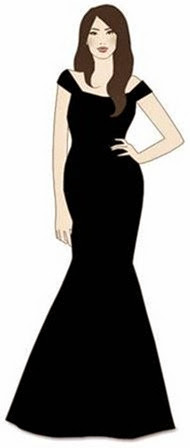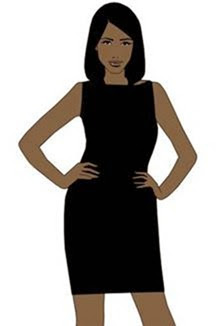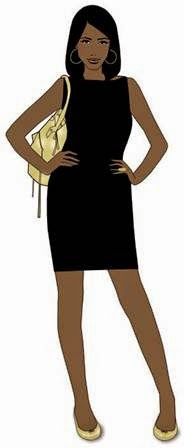From the Runway to a Store Near You
In This Chapter
▶ Following a design from an idea to a store near you
▶ Knowing the difference between haute couture, prêt-a-porter, contemporary, and mass-market
▶ Using this knowledge as you build your own style
Lights, camera, action! Fashion Week in New York City is a twice-a-year extravaganza in the heart of the Big Apple. (There are also other “Fashion Weeks” that take place in cities like Paris and Milan.) Every fashion editor, fashionista, and celebrity is looking for a front-row seat to the hottest shows — not to mention a ticket to the chicest parties! Although much of what is unveiled during Fashion Week is just for show (the more dramatic the better), the events are still a great place for you to educate yourself on upcoming trends and get new ideas for how to put outfits together.
The designers try to catch the attention of the buyers, editors, and fashion media so the wilder and edgier the show, the more attention they get. For the most part, the clothing that actually gets produced is a toned-down version of what was seen on the runway. But that doesn’t mean that you can’t learn any- thing by examining these outfits. This chapter helps you take the looks from the runway to your closet.
From Designer to Mass Market
There isn’t an article of clothing in existence that wasn’t designed by some- body. It could be a creative individual designing for herself, or a professional designing for some segment of the market. Perhaps the design bears the designer’s name, or perhaps it is someone designing for someone else’s label. But even simple white T-shirts require the creative juices of a designer because someone has to pick out the exact cloth, choose the neckline, the length of the sleeves, and so on.
Getting any piece of clothing made takes a variety of steps, whether the garment is from a high-end designer or is mass produced. The process goes like this (see Figure 6-1):
1. The designer comes up with an idea for a garment and creates a sketch, which goes to the pattern maker.
2. The pattern maker draws the actual pattern.
3. Materials are picked and a sample is made.
The sample is fit to a fit model and then scaled up and down in size to accommodate small, medium, large, and so forth. Colors and patterns are also decided, as are any embellishments or details.
4. The design goes off to the showroom (and a runway show if the designer is high-end).
5. The buyers come to look at the merchandise and, if they like it, place orders.
6. The garment is sent to production.
The quantity produced is based largely on the number of sales already made and predicted reorders.
7. The pieces are tagged and shipped off to a store near you.
And you thought the clothes just appeared in the stores!
The following sections provide more specifics about these steps.
Even a T-shirt requires a careful design
You may think a T-shirt is just a T-shirt, but like every other item of clothing, a sketch, pattern, and sample has to be made for every single T-shirt style, too. You can’t just produce a V-neck T-shirt from a basic crewneck sample, or a short-sleeve T-shirt from a long-sleeve one. Each type requires all of the steps outlined in Figure 6-1, which takes time and costs money.
The sleeve length has to be precise when you make either a short-sleeve or a long-sleeve T-shirt — no guesswork is allowed! — and the amount of material used determines how much of that particular fabric has to be purchased. All of this goes into the production costs and, of course, determines the shirt’s cost.
Creating the design
During the early stages of a designing career, a designer works on every little detail with his or her own hands. Often, the higher the designer moves up the ladder of success, the less physical work he or she actually does. Instead, the designer has a staff to carry out the process of cutting, sewing, and so on. In addition, the very famous designers have other designers working under them, which means that once a designer reaches the top rungs of the ladder of success, he or she may never have to sketch out an idea again. (On the other hand some designers are very hands on, and for big celebrity events or weddings, many designers get extremely involved in the process.)
It isn’t enough to just work on patterns and samples (or to direct other people to do so). The other trick to being a successful designer is to be ahead of the game. Designers create patterns and samples for future seasons. While their spring merchandise is just hitting the stores, designers have to have their fall lines ready to show to buyers and editors at Fashion Week. In other words, designers have already thought of, sketched, and produced their designs a season prior to when they’ll come out. Many designers actually work about a year ahead, not just a season ahead. How far in advance they have to design depends on the designer, how big his or her line is, and the size of the overall enterprise.
Keeping their fingers on the public’s pulse
In order to avoid designs that are out of fashion, a designer has to know what the competition is doing and what colors and fabrics are expected to be in fashion in the coming seasons. And because the ultimate buyer is the public, a designer also has to try to gauge what customers’ moods and desires are going to be a few years from now. To do that, designers have to be up on the current trends in music, art, cinema, TV, and so on, as well as try to get ahead of those curves. So, for example, if a major motion picture about some historical era is being made, designers may try to capitalize on that by including one or two outfits in their collections that reflect that era on the off chance that the film becomes a big hit.
King Louis and his dolls; Napoleon and his edicts
Fashion has been an important part of many a country’s economy, notably France. In order to publicize French fashions, King Louis XIV had life-sized fashion dolls made and sent to every court in Europe. Even after dress patterns became widely used, the dolls continued to be made up until World War I, and the mannequins seen in every department store have kept the idea alive even today. The French revolution badly damaged the French fashion industry, and when Napoleon became emperor, he issued many decrees in order to revive it. Among them, he ordered that ladies could not wear the same outfit twice to his court.
Following or bucking trends
The big question every designer has to answer is whether to follow the cur- rent trends or buck them. If hemlines have been inching up, then without a doubt they will head back down at some point, but does a particular designer risk lowering hemlines too early or wait until everyone else heads in that direction? A designer like the late Yves Saint Laurent was such a style setter that virtually every other top designer felt compelled to follow his lead. If Saint Laurent decided that the safari look was in, then almost all the other designers added one or two safari-inspired outfits to their collections.
Saint Laurent even influenced real estate, opening a store on Paris’ Left Bank when the top designers were all based on the right bank and then watching as many others followed suit by also opening stores in the Left Bank.
An established designer can pave his or her own road, but for others it’s a big gamble. Go too far afield, and you may get ignored. But be too conservative, and you stand no chance of breaking out from the pack. Fashion is an art form but also a business, and many a designer has failed because of an inability to cope with both.
Introducing the design
A fashion show is the best way for a designer to get his or her designs out into public view. So how do you score tickets to a designer’s fashion show? It’s not easy. These shows have limited seating, and the seats are primarily reserved for fashion editors, stylists, celebrities, and, of course, the buyers. The people attending the shows filter the information to you via the fashion magazines, celebrities wear the designs to events that are covered in the press, or eventually the buyers bring the designs to a boutique near you. If you want to get a head start, check out the shows online at www.style.com and www.elle.com.
On the runway
If there’s one thought about the world of fashion that is shared by most people when looking at the fashions coming down the runways, it’s “What normal woman could ever wear that?” And you’d have a hard time finding most of those items in a store if you did want to buy them. So why do the clothes displayed on runways end up being so outrageous? The basic answer is to satisfy the fashion media.
The major fashion magazines, Vogue, Harper’s Bazaar, and Elle, can devote only so many pages to covering the fashion shows. Understandably, they show outfits that are eye-catching and innovative. Because it’s vital for designers to get covered in the fashion media, they all know that some of the outfits they send down the runway are for show only. And don’t forget, designers are also artists. Sure, they want to sell clothing, but they also want to express their artistic talents, and sometimes the two don’t necessarily mesh. But that’s fine, as long as you understand that what you’re seeing walking down those runways is both fashion and art (see Figure 6-2).
Fashion Week, be it in New York, Paris, Milan, or wherever, is really more theater than anything else. The point is to get celebrities in the audience, photographers crowding behind the velvet rope, and cause as much buzz as possible. In fact, most of the buying isn’t done at fashion shows at all, but before that in the showrooms.
Figure 6-2: Fashion Week in New York City is always an extravaganza.
In the showroom
The top buyers visit the designers’ showrooms. The buyers then pick and choose what they think will sell best in the stores. Familiar with the most common sizes and most popular colors and styles, these buyers filter even further from the designers’ collections and only buy what they think will actually sell. They place their orders, and based on these orders, the designers determine how much of each item to produce.
That’s not to say that top designers don’t also carry their higher-end apparel at their boutiques and high-end department stores. They absolutely do, and these clothes certainly have aspects of the more innovative designs that are shown on the runway, if not almost exact replicas.
That said, women still get a thrill from wearing the latest trends. So even if it isn’t exactly what’s shown on the runway, women want new clothes that incorporate the new and trendy. Designers know this, and they produce clothes that are actually wearable versions of the theatrical garments shown on the runway. In addition, savvy women know they need to stay true to their lifestyle and body type. Designers, therefore, produce basics, classics, and staples in addition to their current and trendy pieces.
Moving the design toward a wider audience
Other designers, whose names you may not be familiar with, take the same design elements and trends shown on the runways and come up with different lines that are more (or much more) affordable. Elements such as the quality of the fabric and the attention to detail usually determine at which level these clothes fall.
But that’s not the end of the story. Not every garment ends up a big seller. If a particular style sits unsold for too long, it gets marked down in price, just like you see when department stores and boutiques have their big sales. And sometimes designers produce more pieces than they sell to the stores, and if there are no reorders on those designs, these articles can end up at discount outlets like Loehmann’s, or even T.J. Maxx or Marshall’s.
Even the designs themselves may have other lives. If a particular design sells well, you can almost bet that some other clothing manufacturer will make a copy of that design, perhaps using less expensive material and less costly manufacturing processes, and sell the item as a so-called knockoff.
Ranking Clothing: From Haute Couture to Mass Market
Visit a vintage clothing store and you’ll quickly see that just as high-end cars hold their value, so do designer clothes. There’s a real pecking order when it comes to clothes, and the designers fight to make it to the top of the ladder
because along with the fame and adulation comes that pot of gold. The follow- ing list explains how to differentiate between the lines of designer clothing:
✓ Haute couture: This is the highest end. It’s made-to-measure and costs thousands of dollars.
✓ Prêt-a-porter: This line is the next level down in a designer’s collection.
Prêt-a-porter clothing is still high-end and very pricey, but the pieces aren’t one of a kind. The construction, materials, and fit are of impeccable quality. These outfits are shown on the runway, as are the haute couture pieces, and they’re sold at the designers’ boutiques or on the designer floor of the higher-end department stores.
✓ Contemporary: Designers that are mostly well known under their own labels design these pieces. These items are shown in the designers’ own boutiques and are also sold in department stores on the contemporary floor. Contemporary pieces are less expensive than prêt-a-porter.
✓ Mass market: These are more affordable pieces that may or may not have a designer’s name attached. They’re not shown on the runway and are generally mass produced. Because there are a variety of mass market stores, ranging from stores like H&M to Walmart, the prices and the quality of their merchandise vary considerably.
Traditionally, when the term “designer clothing” was used, it meant high-end clothing, that is to say, clothing of limited quantity, high cost, and designed by somebody who, if not a household name, was at least somewhat famous. But beginning in the 1960s with Pierre Cardin, top designers began attaching their names to clothing meant for the masses, so that even babies could be dressed from head to toe in Calvin Klein or Ralph Lauren.
Haute couture
If you are Angelina Jolie and are heading to the Oscars to be photographed for the entire world to see, haute couture is appropriate! Haute couture dresses are made to order for a specific customer and are made from high-quality, expensive fabrics and sewn with extreme detail (see Figure 6-3). Making a haute couture garment is very time-consuming because these creations are hand made. The time and effort is worth it to the designer, though, because having a big celebrity wear a creation is a big coup and gives the designer an enormous amount of press and exposure.
What distinguishes haute couture from every other type of clothing? Most specifically, it’s made for the person wearing it. A woman walks into the salon of a designer and sees various models, chooses one, and then selects exactly what fabric it will be made of. The dress is then hand-sewn to her exact size and specifications. (When this is done for a man, the term used is bespoke, which comes from Saville Row — the London street where the great mens- wear shops are located.)
A designer has to be designated as worthy of the appellation of haute couture. To do so, the French Ministry of Industry must decide whether the house meets certain requirements, including having a minimum of 15 employees and holding fashion shows twice a year, with each show having a minimum of 35 outfits for both day and evening wear. Surprisingly, not every one of today’s most famous designers can use the term “haute couture” to describe its creations. Those who can include Chanel, Givenchy, Yves Saint Laurent, Christian Dior, and Jean Paul Gaultier.
Prêt-a-porter:
The designer’s ready-to-wear line
Haute couture is such a small niche in the fashion market because of its high price tag and the extravagance of the garments themselves. These pieces are mostly crafted for the art of fashion, the drama of the show, and the editorial exposure. They’re not produced on a large scale, if at all. So how do these haute couture fashion designers make a living? Well, they sell their other line — the prêt-a-porter line, or in English, ready-to-wear. This line is at a much more attainable price for the general consumer. Don’t get me wrong: Designer clothing is expensive, but the ready-to-wear line is much more wearable as far as design and much more affordable.
Figure 6-3: A haute couture dress.
Comparing prêt-a-porter to other lines
What distinguishes prêt-a-porter from contemporary and so-called mass market clothing is that the fabrics are of better quality, some hand-sewing may be involved, and there is more attention to detail, all of which allows the designer to charge more. Where a haute couture dress may cost from $3,000 to $10,000 or more, a designer dress of the prêt-a-porter category probably costs between $500 and $2,500.
One of the biggest differences between prêt-a-porter and haute couture is in the design. Haute couture is not necessarily made to be worn by the average person; prêt-a-porter is (see Figure 6-4). And, even though prêt-a-porter is made in greater volume than haute couture, the quality is still top-notch. Make no mistake, when you’re buying from a designer’s ready- to-wear line, you’re getting a high-quality garment made with the finest materials and using the finest labor methods. Some pieces may be hand-stitched or hand- beaded. Another major difference is that prêt-a-porter is fully completed, which is why a customer can go into a store, buy it, and wear it home. In many instances, some alterations have to be made, but because every store has the garment in several sizes, it may actually fit perfectly.
Ways to buy prêt-a-porter
Because prêt-a-porter is not inexpensive, such higher-quality garments are expected to last, both in terms of wear and tear and style. A two-year old dress may be out of style for a fashionista who feels she must dress on the cutting edge, but the quality should be obvious for many years. This gives women two avenues when it comes to purchasing clothing of the prêt-a-porter quality.
Figure 6-4: Prêt-a-porter.
✓ Look for classics at discounted prices: If you can find a high-quality item that didn’t sell when it first came out, it may be deeply discounted. Yes, it may no longer be cutting-edge, but it certainly will still make a statement. The difference in price may make such a purchase very worth- while. And because it is of higher quality, it will also last. So if you find a staple item, like a blazer or little black dress or charcoal wool skirt, that is greatly reduced in price, definitely consider its purchase. Especially if you consider that with a few alterations, like an adjustment to the hem- line, it may actually be right in style.
✓ Consider buying previously owned pieces: Because prêt-a-porter items are more upscale, they most likely weren’t worn very often. Many women don’t like to repeat and will consign items to make money to buy more! See Chapter 7 for more advice on buying vintage clothing, but keep this option in mind when looking for higher-quality garments that may otherwise be out of your reach.
Contemporary
Contemporary designs may have recognizable names but are not considered as high-end as prêt-a-porter. These garments can be sold in the same department stores as the prêt-a-porter lines but are often sold on a different floor. These dresses generally run anywhere from $150 to $450 (see Figure 6-5). A mass market dress, on the other hand, can easily be found for under $100.
Mass market
If you think of fashion as a pyramid, with the haute couture clothes at the top, mass market forms the bottom, and because the bottom is the widest, it encompasses the most variety at the lowest price points.
Stores such as Nordstrom, Macy’s, Kohl’s, and Walmart are all big department stores, but the merchandise you find at each is different. Even though each of these stores is likely to have a selection of black dresses, you’re unlikely to find the same dress, because the buyers for each of these chains has a different price point.
While finding 10s in the mass market category is certainly possible, as Figure 6-6 shows, you have to look a little harder to find the perfect item that also fits your
style and body type.
Figure 6-5: A contemporary black dress.
You can thank Singer
Dressmaking was all done by hand until the middle of the 19th century when technological advances brought major changes. The year 1856 is the landmark year when the Singer Sewing Machine Company was born. The origin of the sewing machine stretched back more than 20 years prior, but when the Singer machine began to be sold in quantity, it was the beginning of a revolution. Tens of thousands of tailors would soon be out of a job, and while at first these machines permitted women to make their own clothes, eventually, as the machines became more elaborate, it spelled the birth of the mass market clothing business, and shops devoted to selling ready-to-wear clothes began to spring up.
Figure 6-6: When buying a mass market LBD, check detailing such as the quality of the stitches.
Building Your Fashion Awareness
Assuming that you’re not going to rush out and buy an outfit in the category of haute couture or maybe even of prêt-a-porter, what does all this have to do with you and your fashion sense? Everything! If you’re going to develop your personal sense of style, you have to have an idea of what’s going on in the fashion world.
At the top is haute couture, and you can never go wrong wearing a designer dress of this caliber because it will be tailored to your measurements, made with exquisite care using the finest cloth, and be of the most cutting-edge design. At the next level, prêt-a-porter, you can be sure that the design is up to date, the fabrics are wonderful, and the manufacturing process is first class. The rest of the market is made up of contemporary designers and mass market merchandise.
Here’s what fashion awareness lets you do:
✓ Invest wisely in your clothing: As you know so well, there’s a very big difference in what you can buy at a department store and a dollar store. As you build your fashionable wardrobe, you have to decide which pieces are worth spending a little more on and which you can spend less on. My advice? Invest smartly in classic pieces and staple items that will stand the test of time as far as quality and style, and spend less on the super trendy items that’ll be out of style before you can bat an eye.
You’ll never feel bad purchasing a few fun, trendy items to wear all season until they are “out” if you didn’t over- spend on them.
✓ Create your own versions of designer fashions: When you keep abreast of what the top designers are doing, you can create your own version of their designs, using merchandise that fits your budget (see Figure 6-7). Every designer, whether a household name or not, has his or her version of the latest trend. So even if you’re getting your ideas from the high-end designers that grace the pages of the fashion magazines (tear out pictures of the pieces you like and take them shopping with you), you’ll still be able to find items that work for you in your budget.
Figure 6-7: With the right accessories, you can dress up even an inexpensive LBD.
✓ Be a savvy shopper: Your goal is to be fashionable, not a slave to fashion! Raising your level of fashion awareness is going to make it a lot easier to buy clothes. You won’t spend time guessing whether or not a particular outfit you see in the stores is fashionable or relying on a sales assistant who may have more incentive to push something that’s not going to sell on its own. Instead, you’ll be able to browse through the racks with confidence, selecting items that will let those around you know that you’re someone who has good fashion sense.
What factors into something being trendy? The shape, hemline, neckline, color, type of material, and so on. How many times have you read that “X color is the new black?” If blue is the new black, for example, then maybe you want to add a little blue to your wardrobe this season.
If you want to be fashion conscious, you need to see what the top designers are doing. The reason is that so many of the designers who produce more affordable clothing will offer similar versions of the same trends the high-end designers produce. By seeing what the top designers are doing, you’ll be able to spot trends that you can then imitate at whatever level comfortably suits your income. Even if you never purchase one of the gowns featured in the coverage Vogue gives to Fashion Week, by understanding what’s being shown, you’ll be able to select outfits in your price range that still reflect the latest trends.
Before you buy something because it’s trendy, make sure it fits into your style and body type. If blue is the new black but it’s not a color that you’re comfortable in or look good in, then avoid it, regardless of the trend. If you’re a women whose body type doesn’t fit the latest fashion — if the latest style
is low-waisted pants when you are long-waisted, for example — don’t follow the herd. Be selective and wear only clothing that fits your body. This doesn’t mean you can’t be trendy. Accessories are very trendy items and are great ways to express your style and fashion sense without falling victim to unflattering hemlines, materials, and so on. Remain true to your style and your body type, and you’ll look fabulous whatever you wear


